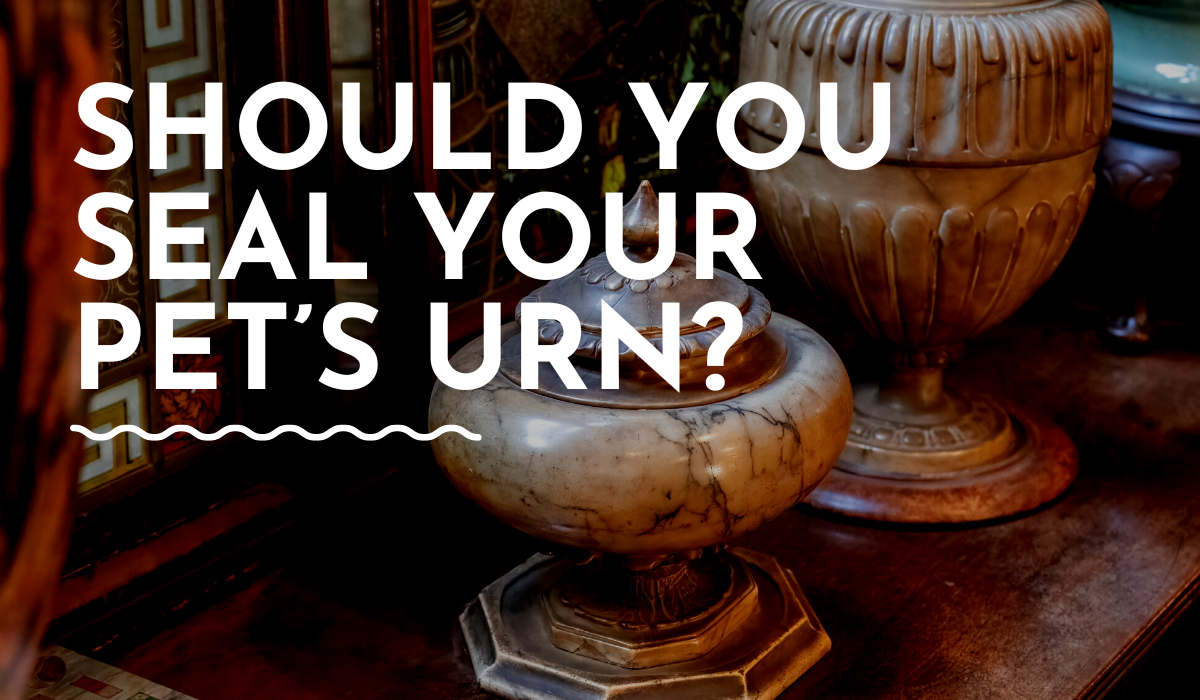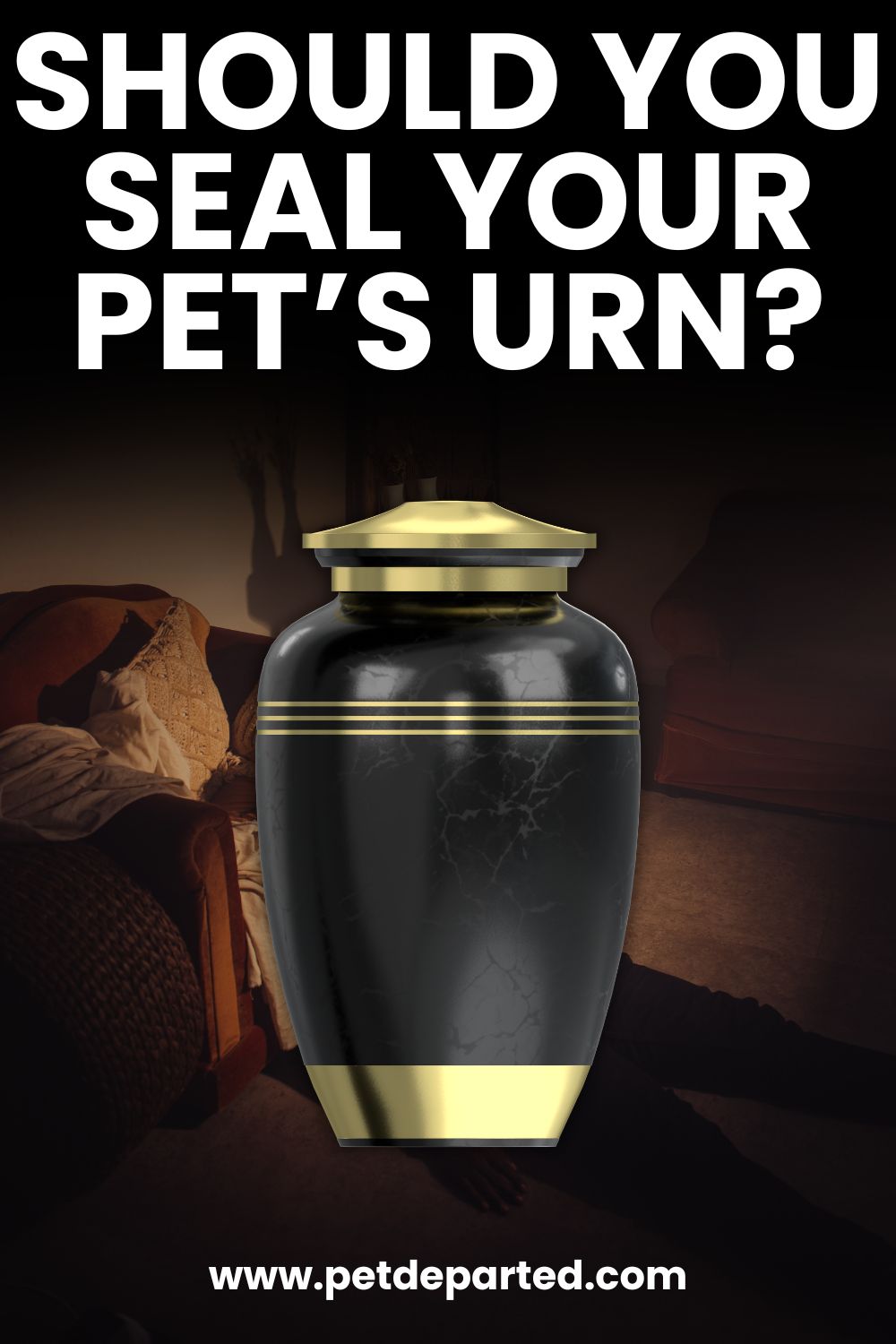Losing a pet can be a difficult and emotional experience, and selecting the appropriate pet urn to commemorate their life and preserve their ashes is an important step for many pet owners who are just starting their grieving journey.
Now, while there are many major and minor things to consider when picking the urn that would hold your beloved companion’s remains forever, one important thing is whether or not the urn should be sealed airtight.
With several pros and cons and advantages and disadvantages to consider, this article will help you decide what to do with your pet’s urn.

What is a Sealed Pet Urn?
A sealed pet urn is a container specifically designed to securely encase and safeguard the ashes of a deceased pet.
These urns are typically airtight or tightly sealed to prevent any accidental leakage or exposure of the remains.
The sealing mechanism ensures that the ashes are protected and permanently preserved, providing a sense of security and reverence for the memory of the beloved pet.
The Advantages of a Sealed Pet Urn
There are several benefits to choosing a sealed pet urn, including the following:
Preservation of ashes: By sealing the ashes inside the urn, pet owners can be confident that their pet’s remains will be protected and preserved for many years.
Peace of mind: For many pet owners, knowing that their pet’s ashes are secure and protected inside a sealed urn can provide comfort and closure.
Protection from spillage: A sealed urn can be especially handy if you have children who could accidentally knock it down and spill the pet’s ashes.
Protection from environmental elements: Sealed pet urns shield the ashes from external factors such as dust, moisture, or sunlight, helping to maintain the integrity of the remains over time.
Ease of handling and transport: Sealed urns are often designed to be sturdy and easy to handle, allowing for convenient storage or transportation if needed, giving pet owners flexibility in how they choose to honor their pet’s memory.
Display options: Sealed urns can be placed in a variety of locations, including on a mantel, bookshelf, or in a special room dedicated to the memory of the pet. They can also be buried in a memorial garden or taken with the pet owner on their travels.
The Disadvantages of a Sealed Pet Urn
While sealed pet urns offer many benefits, there are also some potential drawbacks to consider, including:
Cost: Sealed pet urns are often more expensive than unsealed urns due to the materials and craftsmanship required to create a secure and airtight container.
Limited scattering options: Once the urn is sealed, accessing the ashes for scattering or sharing among family members can be challenging, potentially inhibiting certain memorialization options.
Inability to view ashes: Sealed urns require breaking the seal to be opened, which limits the possibility of visual inspection of the ashes. This may be important for some pet owners as part of their grieving process or to verify the contents.
Unsealed Pet Urns
For pet owners who prefer not to have their pet’s ashes sealed inside an urn, an unsealed pet urn may be a better option.
These urns are typically made from more biodegradable materials, such as wood or ceramic, and do not have a tight-fitting lid or closure.
Unsealed urns are designed to allow the ashes to mix with the earth or scatter more easily.
The Advantages of an Unsealed Pet Urn
Affordable: Unsealed pet urns are often cheaper than sealed urns, as they do not require the same materials or craftsmanship.
Scattering options: Unsealed pet urns allow for more flexibility in scattering the ashes in a special place or location, as they can be easily opened, and the ashes can be released directly into the environment.
The Disadvantages of an Unsealed Pet Urn
Protection of ashes: As the ashes are not contained within a sealed urn, they may be exposed to the elements and may not be protected for as long as with a sealed urn.
Display options: Unsealed urns may not be suitable for display in a prominent location, as they may not provide the same level of protection for the ashes as a sealed urn.
Choosing a sealed or unsealed pet urn is a personal decision that depends on a variety of factors, including personal preference, budget, and intended use.
By weighing the advantages and disadvantages of both options, pet owners can make an informed decision that is best for them and their beloved pets.
Do Pet Urns Need to be Sealed Airtight?
If you plan to keep the urn in a special place, such as on a mantel or bookshelf, and you prefer to have the ashes contained within, then a sealed urn may be the best option for you.
On the other hand, an unsealed urn may be a better choice if you plan to bury the urn or scatter the ashes in a special place.
What is the best sealant for a pet urn?
The best sealant for a pet urn would depend on the material of the urn and the conditions it will be exposed to. Here are some standard options:
Silicone: Silicone is a flexible, waterproof sealant often used in pet urns made of metal or stone. It is resistant to heat and cold, making it ideal for urns displayed in different environments.
Epoxy: Epoxy is a strong, durable sealant ideal for pet urns made of stone or other hard materials. It is resistant to water and chemicals and can be used to create an airtight seal that will protect the ashes for many years to come.
Acrylic: Acrylic sealant is a transparent, water-resistant material ideal for pet urns made of glass or other delicate materials. It can be used to create a clear, glossy finish that will help to protect the ashes and prevent them from becoming exposed.
Ultimately, the best sealant for a pet urn will depend on the specific material and intended use.
How to open a permanently sealed urn?
While it is generally recommended to keep a pet’s urn sealed to ensure the ashes remain undisturbed and protected, there are situations where opening it becomes necessary.
Perhaps a family member wants to add a special keepsake that holds sentimental value, or maybe the urn needs to be transferred to a different location.
Whatever the case may be, here is a step-by-step guide on how to open a permanently sealed urn:
Prepare Your Workspace: Select a stable surface and cover it with a clean cloth. Place the urn on the cloth to protect it from any potential damage during the process.
Gather Necessary Tools: Ensure you have a flathead screwdriver, a rubber mallet or hammer, and a hairdryer available. These tools will assist in opening the urn without causing harm.
Identify the Seal Type: Examine the urn to determine the type of seal used—this could be adhesive, a screw-on lid, soldered metal, or a mix of these.
Soften Adhesive (If Applicable): If the urn is sealed with adhesive, use a hairdryer set on a low heat setting to gently warm the adhesive, making it easier to remove.
Loosen the Seal: Utilize the flathead screwdriver to carefully pry around the edges of the lid or seal. If the urn is particularly resistant, wrap the head of the mallet or hammer in the cloth and gently tap around the edges to assist in loosening the seal.
Open the Urn: Once the seal has been sufficiently loosened, carefully remove the lid or open the urn. Take extra caution to ensure the contents remain undisturbed.
Reseal the Urn (Optional): If you need to reseal the urn after adding keepsakes or transferring ashes, select an appropriate adhesive for the material of the urn. Apply the adhesive as directed, align the lid or seal properly, and press firmly. Allow ample time for the adhesive to set before moving the urn.
Proceed with Patience and Respect: Opening a permanently sealed urn is a sensitive task. Take your time and handle the urn with the respect it deserves. If at any point you feel unsure about proceeding, consider seeking assistance from a professional to avoid unintentional damage or distress.
